Streamlined patient flows with robots at Charoenkrung Pracharak Hospital
)
Robots help handle patient registration and vital signs measurement at the hospital, reducing waiting times and frontline staff workloads
For patients at Charoenkrung Pracharak Hospital (CKPH), a 481-bed public hospital in Bangkok, robots are becoming an increasingly familiar sight.
Since July 2024, three robots – known as Dinsaw Intelligent OPDs – have taken on patient screening tasks. When patients scan their national ID cards on the robot, it verifies their personal information and insurance coverage, and then guides them to measure their blood pressure, height and weight. Based on the results, the robot directs patients to the appropriate department.
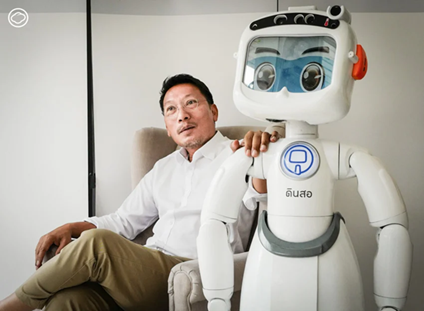 |
The data is simultaneously transmitted to the hospital’s Electronic Medical Record (EMR) system, made possible through an API, said Mr Chalermpon Punnotok, chief executive of CT Asia Robotics which developed Dinsaw. |
Delivering streamlined, efficient patient journeys
The robots are helping to relieve congestion at the registration counters and shorten patients’ waiting times. Serving a population of 248,000, CKPH records over 858,000 outpatient visits each year, or around 2,350 visits per day. Registration areas are often crowded, leading to negative patient experience and heavy workloads for frontline staff.
 |
Dr. Jiraporn Luengmettakul, Head of Health Insurance Department, shared that CKPH now offers three other registration methods, namely digital kiosks, a mobile app (Mor BMA, developed by the Bangkok Metropolitan Administration), and the robots. The different registration options available has reduced the proportion of cases handled manually by counter staff – from 85.9% in 2023 to 76.7% in 2024. |
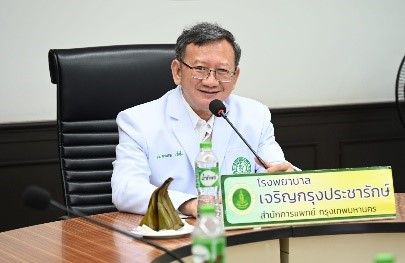 |
Porntep Saeheng, Director of CKPH, highlighted how the robots have helped streamline the patient journey, said. In the past, patients needed to queue at the registration counter, and then at the screening nurse, and again to record their vital signs. These can now all be conducted by the robot in one go. |
“Since the robots were introduced, we have seen shorter waiting queues for registration, and more efficient patient flows. Patient feedback has been positive as well – many liked that they can have two-way communications with the robot,” he said. Over the past year, the number of patients using the robots has jumped from 1,575 to 9,731.
Since introducing the "Dinsaw" medical robot, CKPH has shortened patient registration and vital sign screening time from 25-30 minutes to 5 minutes. This combination of registration and vital sign measurement enables the immediate diagnosis of abnormal blood pressure and pulse rates, enabling prompt medical intervention.
The robot achieves an accuracy rate of over 99 percent for these measurements and goes through regular equipment calibration once a month. As an important safety feature, if the robot detects an abnormal reading, it immediately does a second check. If the reading remains abnormal, an alarm is triggered, directing staff to promptly transport the patient to a doctor or nurse.
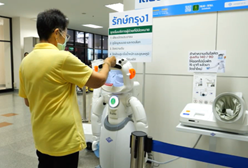
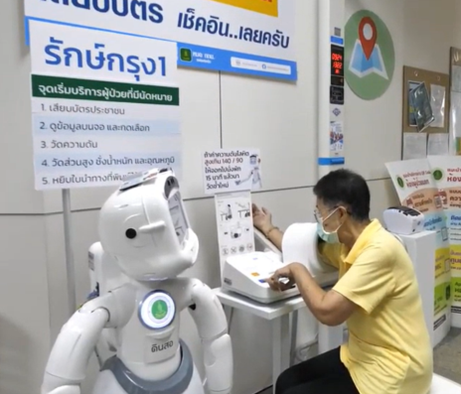
Initially, some patients, especially the less IT savvy, were hesitant to try out the robots. To promote use of the robots, the first step was to ensure staff were fully familiar with the technology, said Dr Porntep.
“Staff must be comfortable with using the robots so they can guide patients in doing so,” he noted. “At the beginning, we stationed an information officer near each robot to guide patients. Over time, our patients are now comfortable using the robots on their own.”
Expanding the role of robotics in healthcare
There are plans to further enhance the capabilities of the robots. At the moment, the robots cannot be used by walk-in patients or new patients who do not yet have a record in the hospital’s system, nor by patients under certain national insurance schemes requiring physical verification. They are also limited to recording basic vital signs and symptoms.
A new ‘all-in-one’ robot that can handle all categories of patients, including walk-ins, has been implemented in another province, shared Mr Chalermpon.
The next focus area lies in AI-driven triage.
“We are developing AI to triage patients based on their reported symptoms. For example, if a patient reports a headache, the AI will ask follow-up questions, such as severity, location of the headache. If it detects red flags or serious cases, it can alert emergency doctors to attend to the patient immediately,” he added.
“We have also developed an AI-driven function to analyse the colour of the patient’s eyes, to provide doctors with more comprehensive screening reports.”
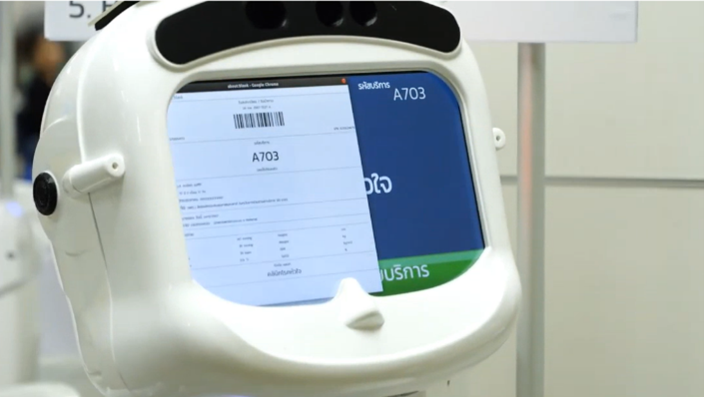
AI and automation key to driving healthcare efficiency
Technology and automation have become central to CKPH’s strategy for improving care delivery. In addition to the robots, the hospital has deployed several other tools in recent years, include automated blood testing systems and pharmacy robots for inpatient wards. It has also invested in an AI-enabled Fundus camera to detect patients at high risk of retinopathy.
Next, the hospital is looking at bringing in an AI-enhanced electrocardiogram solution from Korea to rapidly detect cardiac abnormalities.
“Facing staff shortages, hospitals are increasingly turning to AI to reduce workload and improve efficiency,” said Dr Porntep.
“Ultimately, they help improve patient safety, quality and overall experience. In the future, I believe AI and robotics will become commonplace for patients and staff alike.”

